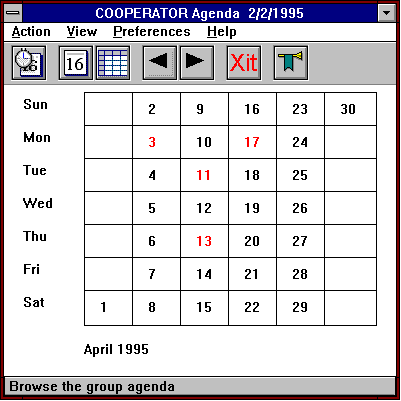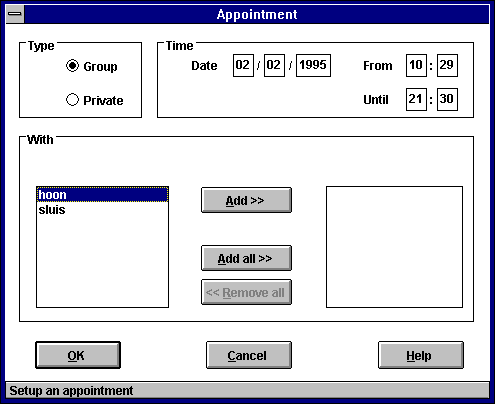


 http://eos.kub.nl:2080/w3thesis/Prototype/agenda_facility.html (Einblicke ins Internet, 10/1995)
http://eos.kub.nl:2080/w3thesis/Prototype/agenda_facility.html (Einblicke ins Internet, 10/1995)In my model of collaborative writing, I stress the need for planning in the beginning of the writing process (e.g., to identify goals and to create an outline), as one of the focal points for support. In the discussion of the effects of computer support for cooperative work, it is argued that especially the early as well as the final stages of intellective cooperative work appear to demand face-to-face communication (Kraut et. al. [1992]). To plan face-to-face meetings, we designed the Agenda.
The Agenda is one of COOPerator's main windows. We call it Agenda because it enables the group members to make appointments. We could have called it Calendar as well, as this is the real-world metaphor we used to imitate a system with which the user is already familiar.

From an ordinary wall-calendar, people can turn a page to view the next month, may be interested in one particular day at which they take a closer look, write down an appointment on any day, and rip off the page depicting a past month.
Analogous, in our computer representation of a calendar, a student may turn the pages by pressing the buttons with the arrows or the corresponding cursor control buttons on his keyboard. He cannot go back until the month before the current month as all previous pages have been 'torn off'. As an advantage over an ordinary calendar, the Agenda always shows the current date in the title bar of the window.
Whenever a group member has one or more appointments on a particular day, the number for that day appears in a contrasting colour. In this prototype, the student is even free to pick his favourite colour. To take a closer look at one of the days in the month, he may point to a compartment containing the wanted date and left-click (with the mouse) once. Alternatively, he may press the button holding the number '16' to turn to day-view. Pressing the button right to that one returns him to month-view.
An appointment is 'written down' by filling in a dialogue box which will appear after pressing the left most button. The following figure shows the dialogue for specification of an appointment:

Of course, all these actions may be triggered from the menu or by pressing a combination of keys on the keyboard (e.g., CTRL+A to make an appointment). The configurable toolbar is optional: it can be toggled on and off from the Preferences menu. An appointment may be erased by using an undo function.
In my examination of real-world metaphors, I mention a known problem with a real-world metaphor like the calendar: it is like reality only different. Slight mismatches between the real-world and the representation on the computer are inevitable. I also suggest that virtual reality techniques can provide designers with novel possibilities to support real-world metaphors to a very large degree.
For example, by using true three-dimensional, virtual reality techniques, a person might actually be able to tear off a sheet from the calendar in the (near) future. Alternatively (and less expensive), this may be visualised using animation techniques. In the discussion on direct manipulation I make clear that the former style of interaction will give the user a greater sense of control then the latter; the computer is then perceived as a medium which is able to represent tools instead of a tool.
And what about making appointments: a student might expect to write an appointment directly on the surface of the calendar using a keyboard or even a pen; just point-and-click at the wanted date and start writing. Similarly, consider erasing an appointment: in the real world a student would probably rub an appointment from the calendar's surface. Maybe we should have handed him an eraser button which he could select to rub out all appointments he wants to cancel. Again, this action-object type of interaction provides COOPerator's users with a greater sense of control. Such issues may be considered for the next version of the COOPerator.
Sjoerd Michels, Tilburg, The Netherlands